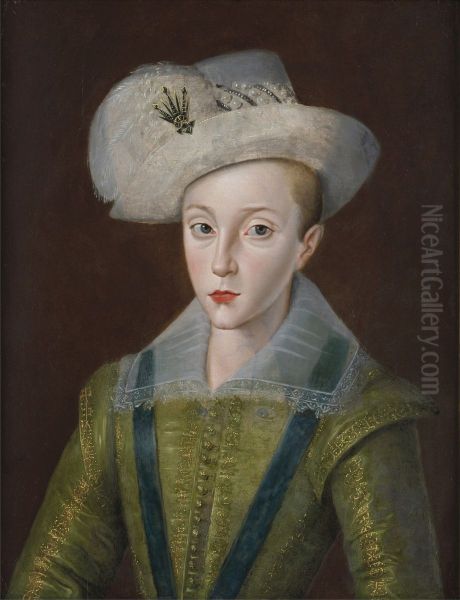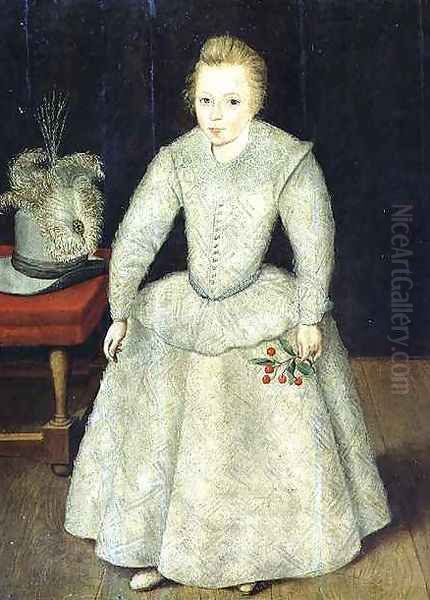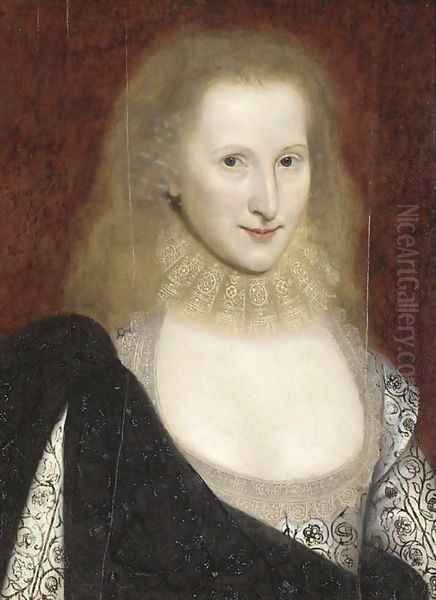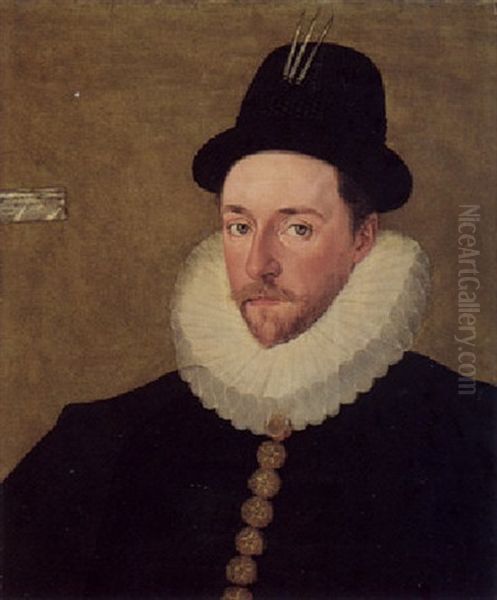Robert Peake the Elder (circa 1551–1619) stands as a significant figure in the narrative of English art, a painter whose career bridged the opulent late Elizabethan era and the burgeoning Jacobean period. Born in Lincolnshire, his artistic journey began not with the brush, but in the meticulous world of a goldsmith's apprentice. This early training likely instilled in him a profound appreciation for detail and craftsmanship, qualities that would later define his portraiture. By the late 1580s, Peake had transitioned to painting, rapidly establishing himself as a sought-after portraitist among the English aristocracy and, eventually, the royal court.
The Artistic Landscape of Elizabethan and Early Jacobean England
To understand Peake's contribution, one must consider the artistic environment in which he worked. Elizabethan England, while culturally vibrant, particularly in literature and theatre, had a portraiture tradition somewhat distinct from the Italian Renaissance or the burgeoning Baroque movements on the continent. English portraiture of this period, heavily influenced by Flemish and German artists like Hans Holbein the Younger (who had worked for Henry VIII) and later Hans Eworth, often prioritized a detailed rendering of costume, jewels, and heraldic symbols over psychological depth or naturalistic three-dimensionality. These portraits were statements of status, lineage, and wealth.
The miniature tradition, exemplified by masters like Nicholas Hilliard and his pupil Isaac Oliver, also cast a long shadow. Hilliard, in particular, championed a style characterized by linear elegance, bright, clear colours, and an almost shadowless illumination, often set against a vibrant blue background. This aesthetic, emphasizing pattern and rich surface detail, resonated deeply with the Elizabethan love for intricate design and symbolism. Peake’s work, especially in its earlier phases, clearly shows an affinity with this native tradition.

As the Jacobean era dawned with the accession of King James I in 1603, new influences began to arrive, though the fundamental taste for detailed representation of status remained. Artists from the Low Countries, such as Marcus Gheeraerts the Younger and John de Critz the Elder, were prominent at court. Gheeraerts, in particular, introduced a slightly greater sense of volume and a more sophisticated handling of space, though still within a framework that valued elaborate costume. Peake would find himself working alongside and in competition with these figures.
Peake's Ascent and Royal Patronage
Robert Peake's skill in capturing the lavish attire and dignified bearing of his sitters quickly brought him to the attention of influential patrons. His portraits from the 1590s demonstrate a mature style, characterized by rich, jewel-like colours, meticulous attention to the textures of fabrics – silks, satins, lace, and embroidered velvets – and a clear delineation of form. While often described as lacking the perspectival depth seen in continental art, Peake's compositions possess a strong decorative quality and an undeniable presence.
A pivotal moment in Peake's career came with the change of monarchy. In 1604, he was appointed official painter to Prince Henry Frederick, the promising heir to James I. This was a prestigious position, placing Peake at the heart of royal artistic patronage. Prince Henry was a keen collector and patron of the arts, and his court was a hub of cultural activity. Peake produced several notable portraits of the young prince, often depicting him in martial attire or engaged in princely pursuits, emphasizing his regal status and future promise.
Further recognition followed in 1607 when Peake, jointly with John de Critz the Elder, was appointed Serjeant Painter to King James I. This was the highest office for a painter in England, a role previously held by figures like George Gower. The responsibilities of the Serjeant Painter were diverse, extending beyond easel portraiture to include the decoration of royal residences, the painting of banners and heraldic devices, and even the design of scenery for court masques and entertainments. This appointment underscores Peake's versatility and his established reputation within the court. He shared a close professional and personal relationship with de Critz; they were neighbors and possibly shared a studio near the Church of St. Sepulchre-without-Newgate in London.
Artistic Style and Techniques
Robert Peake's artistic style is a fascinating blend of native English traditions and an awareness, however selectively adopted, of continental developments. His early training as a goldsmith is often cited as an influence on his meticulous rendering of detail, particularly in jewelry, embroidery, and armor. His paintings are rich in information, serving almost as documents of the elaborate fashions and social codes of the era.

A hallmark of Peake's work is its emphasis on pattern and surface. The intricate designs of lace collars and cuffs, the complex embroidery on doublets and gowns, and the gleam of pearls and precious stones are rendered with painstaking care. This focus on the decorative elements often leads to a flattening of pictorial space, a characteristic shared with Hilliard's miniatures and much Elizabethan panel painting. Figures are typically presented with a strong, clear outline, and modeling, while present, does not create a profound sense of three-dimensional volume in the way that, for example, the work of Italian masters like Titian or later Flemish artists like Peter Paul Rubens would.
Colour in Peake's paintings is typically rich and vibrant, often employing strong contrasts. He excelled in depicting the sumptuous textures of fabrics, from the sheen of satin to the plushness of velvet. Heraldry also played a significant role in his compositions, with coats of arms and symbolic devices often included to signify the sitter's lineage and status. This aligns with the broader Elizabethan and Jacobean preoccupation with ancestry and social hierarchy.
While Peake's work generally shows less concern for anatomical accuracy or deep psychological insight compared to some of his continental contemporaries like Frans Pourbus the Younger or Scipione Pulzone, his portraits convey a powerful sense of dignity and presence. His sitters are presented with a formal gravity appropriate to their station. There is an "iconic" quality to many of his portraits, where the individual is presented as an embodiment of their social role.
Interestingly, Peake was not entirely unaware of continental artistic theories. He is credited with translating parts of Sebastiano Serlio's influential architectural treatise, "Architettura," into English. This suggests an intellectual engagement with Renaissance principles of design and perspective, even if these were not fully or consistently integrated into his painting practice. This translation, however, was a significant contribution, helping to disseminate Italian Renaissance architectural ideas in Northern Europe.
Notable Works and Their Characteristics
Several key works are attributed to Robert Peake the Elder, offering insights into his style and patronage.
One of the most famous, though sometimes debated in attribution, is the "Procession Portrait" of Queen Elizabeth I (circa 1600-1603), now in a private collection (often associated with the Peter Jackson Collection, Look and Learn). This large allegorical painting depicts the aging queen, a vision in white and pearls, being carried on a litter by her noblemen. It is a quintessential example of late Elizabethan state portraiture, emphasizing majesty, symbolism (the "Virgin Queen" iconography), and the intricate detail of costume. The figures are somewhat stylized, and the composition prioritizes symbolic arrangement over naturalistic grouping. If Peake was indeed the primary artist, it showcases his ability to manage large-scale, complex compositions laden with meaning.

Portraits of Prince Henry Frederick are central to Peake's oeuvre. A notable example, circa 1610, is housed in the Baltimore Museum of Art. It depicts the young prince standing full-length, clad in armor, his hand resting on a helmet. The meticulous rendering of the armor, the rich red of the tablecloth, and the prince's composed, regal demeanor are characteristic of Peake's approach. These portraits served to project an image of a capable and martial heir, crucial for the stability of the Stuart dynasty. Another portrait of Prince Henry, often depicted with a lance or in hunting attire, further emphasizes his princely virtues.
The portrait of Peregrine Bertie, 13th Baron Willoughby de Eresby (circa 1590), located at Grimsthorpe Castle (Ancaster Collection), is another significant work. This panel painting shows the nobleman in elaborate attire, his figure set against a plain background, drawing full attention to his costume and dignified pose. The handling of the lace ruff and the detailed embroidery on his clothing are typical of Peake's meticulous technique.
Peake also painted numerous portraits of other members of the aristocracy and gentry. While not all works can be definitively attributed due to the workshop practices of the time (where assistants might complete parts of a painting), a consistent style associated with Peake emerges. These include portraits of ladies in elaborate farthingales and gentlemen in richly decorated doublets and hose. The so-called "Unton Inventories" (or the large commemorative painting of Sir Henry Unton, which includes numerous scenes from his life and death) has also been associated with Peake's circle, showcasing a narrative and allegorical complexity. The reference to "Paradistami" in the initial query likely alludes to such complex, multi-scene commemorative works, which were a feature of the period.
He also produced portraits of King James I, fulfilling his duties as Serjeant Painter. These official likenesses were important for disseminating the royal image throughout the kingdom and abroad.
Contemporaries, Collaborations, and Competition
The art world of Jacobean London was relatively small, and painters often knew each other, collaborated, or competed for commissions. Peake's primary collaborator, as mentioned, was John de Critz the Elder. Their joint appointment as Serjeant Painters suggests a close working relationship, and they likely shared responsibilities for major court projects. De Critz, of Flemish descent, had a style that complemented Peake's, and together they dominated official royal art production for a period.

Marcus Gheeraerts the Younger was another major figure at the Jacobean court and a significant competitor. Also of Flemish origin, Gheeraerts was particularly favored by Queen Anne of Denmark, James I's consort. His portraits, such as the famous "Ditchley Portrait" of Elizabeth I (though earlier) or his many portraits of Jacobean nobles, often display a greater elegance and a softer, more atmospheric quality than Peake's, with a more sophisticated understanding of anatomy and a gentler modeling of features.
William Larkin, active slightly later but overlapping with Peake's later career, is another contemporary known for his highly detailed and somewhat "flat" depictions of Jacobean courtiers in extravagant costume, often set against richly patterned carpets and curtains. His works share with Peake's an intense focus on the decorative qualities of attire.
The influence of earlier miniaturists like Nicholas Hilliard and Isaac Oliver remained pervasive. While Peake worked primarily on a larger scale, the aesthetic principles of clarity, detailed ornamentation, and symbolic richness championed by the miniaturists were deeply ingrained in English taste and are reflected in his panel paintings.
One must also consider the presence of other, perhaps less famous, painters working in London at the time, including native-born artists and émigrés from the continent. The demand for portraits was high among the nobility and the increasingly wealthy merchant class. Artists like George Gower (Serjeant Painter before Peake and de Critz) and William Segar (who was also a herald and Garter King of Arms) contributed to the diverse tapestry of English portraiture. Even a brief visit by an artist like the Italian Federico Zuccaro in the 1570s could leave an impression, introducing different stylistic possibilities. The Dutch painter Cornelius Ketel also worked in England for a period during Elizabeth's reign.
Anecdotes, Mysteries, and Wider Cultural Connections
Robert Peake's life and career are not without their share of intriguing details and unresolved questions. His family background itself presents complexities, with the name "Peake" (and its variants like "Peck" or "Peke") appearing in various records, making genealogical research challenging. Some of his descendants were reportedly exiled for their anti-monarchist stance during later political upheavals, adding a layer of drama to the family history.
A fascinating, though speculative, connection links Peake to the world of theatre. It has been suggested that he might have been involved in painting portraits associated with William Shakespeare's First Folio, published in 1623, shortly after Peake's death. Given Peake's role in designing for court masques and his connections within London's cultural circles, such an involvement is plausible, though direct evidence remains elusive. The King's Men, Shakespeare's acting company, enjoyed royal patronage, creating a potential nexus.
There is also a shadowy, unproven suggestion of Peake's possible peripheral involvement or knowledge related to the Babington Plot of 1586, a Catholic conspiracy to assassinate Queen Elizabeth I. No concrete evidence supports his direct participation, and such associations were often dangerous and based on tenuous connections during that volatile period.
The attribution of certain works also remains a subject of art historical debate. For instance, a portrait thought to be of Benjamin Harlaken of York has been linked to Peake, but its definitive authorship, like that of many paintings from this era, is not conclusively established. Workshop practices, where multiple hands might contribute to a single piece, complicate attributions.
Peake's translation of Serlio's "Architettura" is a significant but perhaps underappreciated aspect of his career. It demonstrates an intellectual curiosity extending beyond the immediate demands of portrait painting and highlights his role as a conduit for Renaissance ideas into England. This act of translation connected him to a broader European intellectual current and had implications for the development of English architecture and design.
Later Years, Death, and Legacy
Robert Peake the Elder continued to work into the second decade of the 17th century, but by the time of his death in 1619 (he was buried on October 11th of that year in St Sepulchre-without-Newgate), the artistic landscape in England was beginning to shift. While his style had served the tastes of the late Elizabethan and early Jacobean courts well, new influences were on the horizon.
The arrival of artists like Daniel Mytens from the Netherlands in the 1610s, and later, more dramatically, Anthony van Dyck in the 1630s, would revolutionize English portraiture. These artists brought a greater naturalism, psychological depth, and a more fluid, painterly technique that contrasted with the meticulous, linear style of Peake and his contemporaries. Van Dyck, in particular, would establish a new paradigm for aristocratic portraiture in England, one that emphasized elegance, movement, and a more romantic sensibility.
Nevertheless, Robert Peake's contribution remains significant. He was one of the leading English-born painters of his generation, successfully navigating the demands of royal and aristocratic patronage. His works provide an invaluable visual record of the personalities, fashions, and social hierarchies of a pivotal period in English history. His meticulous attention to detail, his rich use of colour, and his ability to convey a sense of formal dignity ensured his success.
His influence can be seen in the work of his sons, William Peake and Walter Peake, who also became painters, continuing the family tradition. More broadly, Peake represents a high point in a distinctively English mode of portraiture, one that valued decorative richness and symbolic representation. While later styles would supersede it, the art of Peake and his contemporaries like Gheeraerts and de Critz offers a unique window into the visual culture of late Tudor and early Stuart England. His role as Serjeant Painter and his work for Prince Henry place him at the center of artistic production at the Jacobean court.
Conclusion: Peake's Place in Art History
Robert Peake the Elder was more than just a face-painter; he was an important cultural figure in Jacobean England. As a goldsmith turned painter, a royal servant, and a translator of architectural theory, his career reflects the diverse skills and intellectual currents of his time. His portraits, with their lavish detail and formal compositions, capture the essence of an era that prized display, lineage, and order.
While his style might appear somewhat stiff or archaic when compared to the later Baroque dynamism of Van Dyck or the profound humanism of Rembrandt (a younger continental contemporary), Peake's work must be judged within its own historical and cultural context. He masterfully fulfilled the expectations of his patrons, creating images that were both aesthetically pleasing and ideologically potent. His paintings are not merely likenesses but carefully constructed statements about power, status, and identity in early modern England.
His legacy lies in the rich visual archive he created, in his contribution to the office of the Serjeant Painter, and in his role in disseminating Renaissance architectural ideas. Robert Peake the Elder remains a key artist for understanding the transition from Elizabethan to Jacobean art, a skilled practitioner who left an indelible mark on the visual culture of his nation. His dedication to craftsmanship, evident in every meticulously rendered jewel and every intricate fold of fabric, ensures his enduring importance in the history of English painting.